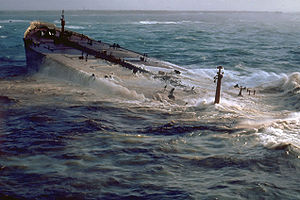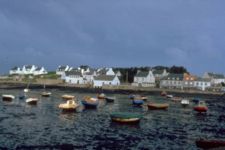
Amoco Cadiz
Background Information
SOS Children produced this website for schools as well as this video website about Africa. SOS Children has looked after children in Africa for forty years. Can you help their work in Africa?
 |
|
| Career | |
|---|---|
| Name: | Amoco Cadiz |
| Owner: | Amoco Transport Co. |
| Port of registry: | |
| Builder: | Astilleros Españoles, S.A. Cádiz, Spain |
| Yard number: | 95 |
| Laid down: | 24 November 1973 |
| Launched: | 1974 |
| Completed: | May 1975 |
| Out of service: | 16 March 1978 |
| Identification: | IMO number: 7336422 |
| Fate: | Sunk at 48.6°N 4.7°W Coordinates: 48.6°N 4.7°W |
| Notes: | |
| General characteristics | |
| Tonnage: | 233,690 DWT; 109,700 GRT |
| Length: | 334.02 m (1,095.9 ft) |
| Beam: | 51.06 m (167.5 ft) |
| Draught: | 19.80 m (65.0 ft) |
| Installed power: | 22,700 kW 1 x 30,400 hp diesel engine |
| Propulsion: | Single screw |
| Speed: | 15 knots (28 km/h) |
| Capacity: | 1.6 million barrels (250×103 m3) |
| Crew: | 44 |
| Notes: | |
Amoco Cadiz was a very large crude carrier (VLCC), owned by Amoco, that ran aground on Portsall Rocks, 5 km (3.1 mi) from the coast of Brittany, France, on 16 March 1978, and ultimately split in three and sank, all together resulting in the largest oil spill of its kind in history to that date.
Sequence of events
En route from the Persian Gulf to Rotterdam, Netherlands, via a scheduled stop at Lyme Bay, Great Britain, the ship encountered stormy weather with gale conditions and high seas while in the English Channel. At around 09:45, a heavy wave hit the ship's rudder and it was found that she was no longer responding to the helm. This was due to the shearing of Whitworth thread studs in the Hastie four ram steering gear, built under licence in Spain, causing a loss of hydraulic fluid. Attempts to repair the damage were made but proved unsuccessful. While the message "no longer manoeuvrable" and asking other vessels to stand by was transmitted at 10:20, no call for tug assistance was issued until 11:20.
The German tug Pacific responded to Amoco Cadiz at 11:28, offering assistance under a Lloyd's Open Form (see below). It arrived on the scene at 12:20, but because of the stormy sea, a tow line was not in place until 14:00, and broke off at 16:15. Several attempts were made to establish another tow line and Amoco Cadiz dropped its anchor trying to halt its drift. A successful tow line was in place at 20:55, but this measure proved incapable of preventing the supertanker from drifting towards the coast because of its huge mass and Force 10 storm winds.
At 21:04 Amoco Cadiz ran aground the first time, flooding its engines, and again at 21:39, this time ripping the hull and starting the oil spill. Her crew was rescued by French Naval Aviation helicopters at midnight, and her captain and one officer remained aboard until 05:00 the next morning.
At 10:00 on 17 March the vessel broke in two, releasing its entire cargo of 1.6 million barrels (250,000 m3) of oil, and broke again eleven days later from the buffeting of high stormy seas. The wreckage was later completely destroyed with depth charges by the French Navy.
Lloyd's Open Form
An argument arose between the captain of Amoco Cadiz, Pasquale Bardari, and that of the captain of the German tug Pacific, Hartmut Weinert, on the issue of Lloyd's Open Form (LOF). Captain Weinert thought this a classic LOF case, an oil tanker with damage to its steering gear, rough weather and getting closer to the shore by the minute.
At the time of the accident, the ship and the cargo were valued at about US$40 million, so Captain Weinert's company could, in the event of success, have received a large award. Captain Bardari of the Cadiz, on the instructions of his owners, wanted "....towage rate to Lyme Bay."
The argument dragged on from 11:28 when Pacific first made contact with Amoco Cadiz until 16:00 when Captain Bardari finally received approval to accept the LOF from the ship's owners in Chicago. However, this dispute did not delay the salvage operation significantly, because tugging preparations had already started. Captain Weinert was aware that if he were to succeed in bringing the tanker into Lyme Bay on the English coast, his owners could arrest the ship in the English High Court in pursuit of a claim for salvage.
It was incorrectly reported in the press at the time that, after long negotiations on financial terms between the ship's captain and the master of a West German tugboat and two unsuccessful towing attempts, the towline finally broke during the argument and the ship drifted onto the rocks. This version of events became fixed in the public mind although in fact delay was caused by Captain Bardari of Amoco Cadiz contacting her owners in Chicago for instructions. The delay in sending a distress message meant that the larger tug Seefalke, which might have been in range an hour earlier, was no longer nearby when the distress call was made.
Oil spill
Amoco Cadiz contained 1,604,500 barrels (219,797 tons) of light crude oil from Ras Tanura, Saudi Arabia and Kharg Island, Iran. Severe weather resulted in the complete breakup of the ship before any oil could be pumped out of the wreck, resulting in its entire cargo of crude oil (belonging to Shell) and 4,000 tons of fuel oil being spilled into the sea.
A 12 mi (19 km) long slick and heavy pools of oil spread onto 45 mi (72 km) of the French shoreline by northwesterly winds. Prevailing westerly winds during the following month spread the oil approximately 100 mi (160 km) east along the coast. One week after the accident, oil had reached Côtes d'Armor.
Oil penetrated the sand on several beaches to a depth of 20 in (510 mm). Sub-surface oil separated into two or three layers due to the extensive sand transfer that occurred on the beaches during rough weather. Piers and slips in the small harbors from Porspoder to Brehat Island were covered with oil. Other affected areas included the pink granite rock beaches of Trégastel and Perros-Guirec, as well as the tourist beaches at Plougasnou. The total extent of oiling one month after the spill included approximately 200 miles (320 km) of coastline. Beaches of 76 different Breton communities were oiled.
Oil persisted for only a few weeks along the exposed rocky shores that experienced moderate to high wave action. In the areas sheltered from wave action, however, the oil persisted in the form of an asphalt crust for several years.
Environmental impact
The isolated location of the grounding and rough seas hampered cleanup efforts for the two weeks following the incident.
As mandated in the " Polmar Plan", the French Navy was responsible for all offshore operations while the Civil Safety Service was responsible for shore cleanup activities. Although the total quantity of collected oil and water reached 100,000 tons, less than 20,000 tons of oil were recovered from this liquid after treatment in refining plants.
The nature of the oil and rough seas contributed to the rapid formation of a "chocolate mousse" emulsification of oil and water. This viscous emulsification greatly complicated the cleanup efforts. French authorities decided not to use dispersants in sensitive areas or the coastal fringe where water depth was less than 50 meters. Had dispersant been applied from the air in the vicinity of the spill source, the formation of mousse might have been prevented.
At the time, Amoco Cadiz incident resulted in the largest loss of marine life ever recorded from an oil spill. Mortalities of most animals occurred over the two months following the spill. Two weeks following the accident, millions of dead mollusks, sea urchins, and other bottom dwelling organisms washed ashore.
Diving birds constituted the majority of the nearly 20,000 dead birds that were recovered. The oyster mortality from the spill was estimated at 9,000 tons. Fishermen in the area caught fish with skin ulcerations and tumors.
Some of the fish caught in the area reportedly had a strong taste of petroleum. Although echinoderm and small crustacean populations almost completely disappeared, the populations of many species recovered within a year. Cleanup activities on rocky shores, such as pressure-washing, also caused habitat impacts.
Amoco Cadiz spill was one of the most studied oil spills in history. Many studies remain in progress. This was the largest recorded spill in history and was the first spill in which estuarine tidal rivers were oiled. No follow-up mitigation existed to deal with asphalt formation and problems that resulted after the initial aggressive cleanup.
Additional erosion of beaches occurred in several places where no attempt was made to restore the gravel that was removed to lower the beach face. Many of the affected marshes, mudflats, and sandy beaches, were low-energy areas. Evidence of oiled beach sediments can still be seen in some of these sheltered areas. Layers of sub-surface oil still remain buried in many of the impacted beaches.
Culture
The ship and spill features in one of Steve Forbert's songs about oil pollution. Speedy J has a song named Amoco Cadiz on his album A Shocking Hobby.
Legal claims
In 1978, it was estimated to have caused US$250 million in damage to fisheries and tourist amenities. The French government presented claims totalling US$2 billion to United States courts.
In subsequent legal proceedings in Chicago, United States, the owners of the tug were held to have been completely blameless while France was awarded US$120 million from the American oil company Amoco in 1990.


